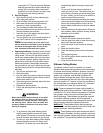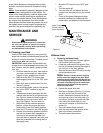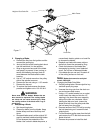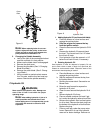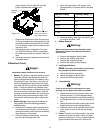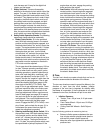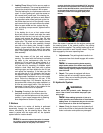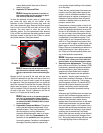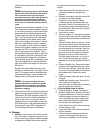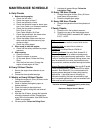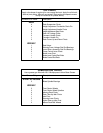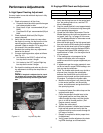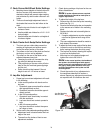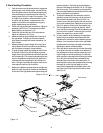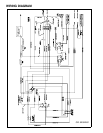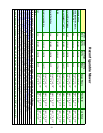24
whenever the lap bars are in their Neutral
positions.
Note: Both lap bars must be in their Neutral
positions for the Park brake interlock mecha
-
nism to function so as to prevent lap bar
movement (movement that would activate the
hydrostatic pumps producing Forward or
Reverse travel rotation of the wheel motors)
and to allow the Park Brake switch to be acti
-
vated.
Whenever the Park Brake is applied (I.E., the
Park brake lever moved completely rearward
in the control panel slot), the lap bars should
be secured in their Neutral positions by the
linkage rods moving into the holes in the lap
bars. This lap bar Neutral lock mechanism
also activates the Park brake switch, which
allows for the engine to be started. If the lap
bars are in their Neutral positions, and they
are not “locked” so as to prevent movement
when the Park brake is applied, then the link
-
age from the RTN on the hydrostatic pumps
and the lap bars must be adjusted. This is
done by determining which side (or both) rod
is not aligned to the hole in the lap bar, then
locating that side linkage rod turn-buckle at
the hydrostatic pump RTN, loosening the jam
nuts and lengthening or shortening the link
-
age rod so that the rod snaps into the hole in
the lap bar.
Dampers are incorporated into the lap bar
linkage to provide smooth, non-jerkey, control
action. The damper rate can be adjusted by
relocating the damper - lower to reduce the
damper action, and elevate to increase.
Note: The engine should be able to be
started whenever the Park Brake is applied,
and the lap bars are locked in their Neutral
positions - if not, the switch may need to be
adjusted or replaced.
5. Whenever the ZTM is on level ground with the
engine running and the lap bars in their Neu
-
tral positions, the ZTM should not creep (I.E.,
move in the Forward or Reverse directions of
travel). If this occurs, contact your Service
representative for the procedure to reset the
RTN mechanism on the hydrostatic pumps. If
the hydrostatic pump RTN is adjusted, the
control linkage must also be readjusted.
H. Storage
1.
General:
If your mower will not be in service
for a few months, it should be stored in a dry
location that is not subject to drastic changes
in temperature. Before storing, the following
maintenance procedures should be per
-
formed.
a. Clean the mower. The entire tractor and
cutting deck should be washed and
cleaned.
b. Sharpen the blades so that the mower will
be ready to use when needed.
c. Protect the metal surfaces. Repair
scratches with the appropriate touch-up
spray paint. Brush a rust preventive oil on
any unpainted surfaces including the pul
-
leys and blades. (Be careful not to get any
oil on the drive belts.)
d. Lubricate the mower.
e. Drain the engine oil. The engine should be
warm so that all the oil drains. Replace the
engine oil filter and refill the crankcase with
fresh oil.
f. Gasoline Engine: Drain all the fuel. Close
the fuel tank shutoff valve. Disconnect the
fuel line from the carbuetor and put the end
into an approved fuel container. Open the
fuel tank shutoff valve and drain the fuel
tank and line into the approved container.
Replace the fuel line on the carburetor.
Start the engine and allow it to run out of
fuel. This will prevent gum and varnish
deposits from forming. Replace the fuel fil
-
ter.
g. Gasoline Engine Only: Remove the spark
plugs and pour approximately one ounce
of oil into each cylinder. Crank the engine
one or two turns to spread the oil evenly on
the cylinder walls. Replace the spark
plugs.
h. Clean the battery and make sure it is fully
charged.
i. Inspect the hydraulic hoses, lines and fit-
tings. Replace as necessary.
j. Jack the mower up and store it on blocks to
take the weight off of the tires.
2. To Put the Mower Back in Service:
a. Check the battery. Charge if necessary.
b. Gasoline Engine Only: Remove the spark
plugs and wipe them off. Using the starter,
crank the engine to pump the excess oil
out of the spark plug holes. Replace the
spark plugs and the ignition leads. Refill
the fuel tank with fresh gasoline.
c. Check the level of the oil in the crankcase
and the hydraulic tank.
d. Lower the mower off the block and check
the tire pressure.
e. Push the mower outdoors and start the
engine. Let the engine idle until it has
warmed up completely (4 to 5 minutes).



